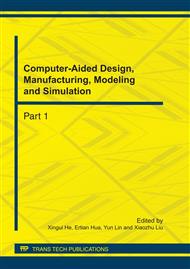p.668
p.674
p.679
p.684
p.688
p.697
p.703
p.709
p.714
Research on Processing Techniques of Logging-While-Drilling Signal Based on BPSK Continuous Wave
Abstract:
The system of Logging-While-Drilling based on BPSK continuous wave is important for horizontal well prospecting. In this paper, the processing techniques of BPSK signal received on the ground have been studied. However, it is difficult to acquire the useful signals, since including most of reflective and mud pump noises. Based on the signal’s characteristic of sine, a new difference filter method, which is in the time field, is put forward. The method combines with the band-pass filter, which is in the frequency field, to reject the noises. Costas phase-locked loop technology and number control oscillator have been used in decoding technology, which can demodulate phase information and decode the BPSK signal. By the analyses in theory and experiment, the signal can be correctly decoded.
Info:
Periodical:
Pages:
688-694
Citation:
Online since:
August 2011
Authors:
Keywords:
Price:
Сopyright:
© 2011 Trans Tech Publications Ltd. All Rights Reserved
Share:
Citation:


